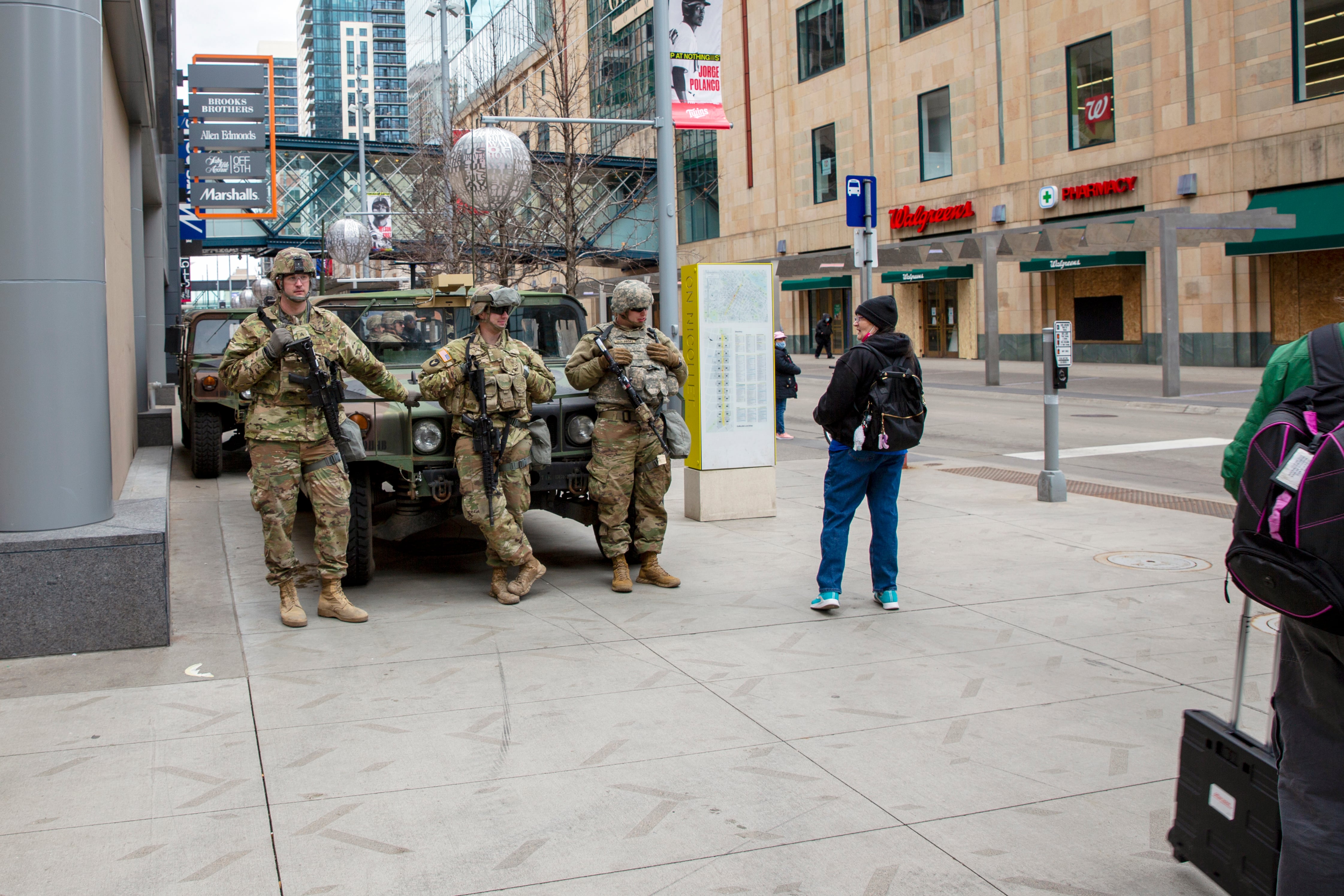MINNEAPOLIS — Posted up outside a grocery store on a chilly, windswept street in downtown Minneapolis earlier this week, rifle over his shoulder, the sergeant first class knew he and his soldiers shouldn’t be here.
“I assumed floods, (overseas deployments) and tornado stuff,” the Minnesota National Guardsman told Military Times of his unit’s traditional duties. “I never thought I’d be standing on a street corner.”
But that’s where 3,000 Guard soldiers and airmen have found themselves in recent weeks, as the world waited to see whether a jury would convict former Minneapolis police officer Derek Chauvin for murdering George Floyd, the Black man whose death beneath Chauvin’s uniformed knee was captured on video last spring, nearly nine minutes of infamy that unleashed calls for reform and peaceful protest, but also fires, looting and destruction across the Twin Cities last summer.
Guard members like the sergeant, who asked not to be named because he wasn’t authorized to speak to a reporter, were mobilized by city and state leaders under “Operation Safety Net” with the hopes of tamping down any destructive intent should Chauvin have been acquitted.
The Guard’s role was fast-tracked after the April 11 police shooting of 20-year-old Daunte Wright in the suburb of Brooklyn Center.
Officials say former Brooklyn Center police officer Kim Potter accidentally shot Wright during a traffic stop when she meant to tase him.
The killing of Wright prompted at-times violent protests in Brooklyn Center and the Guard was called in as multi-night curfews went into effect across several area counties.
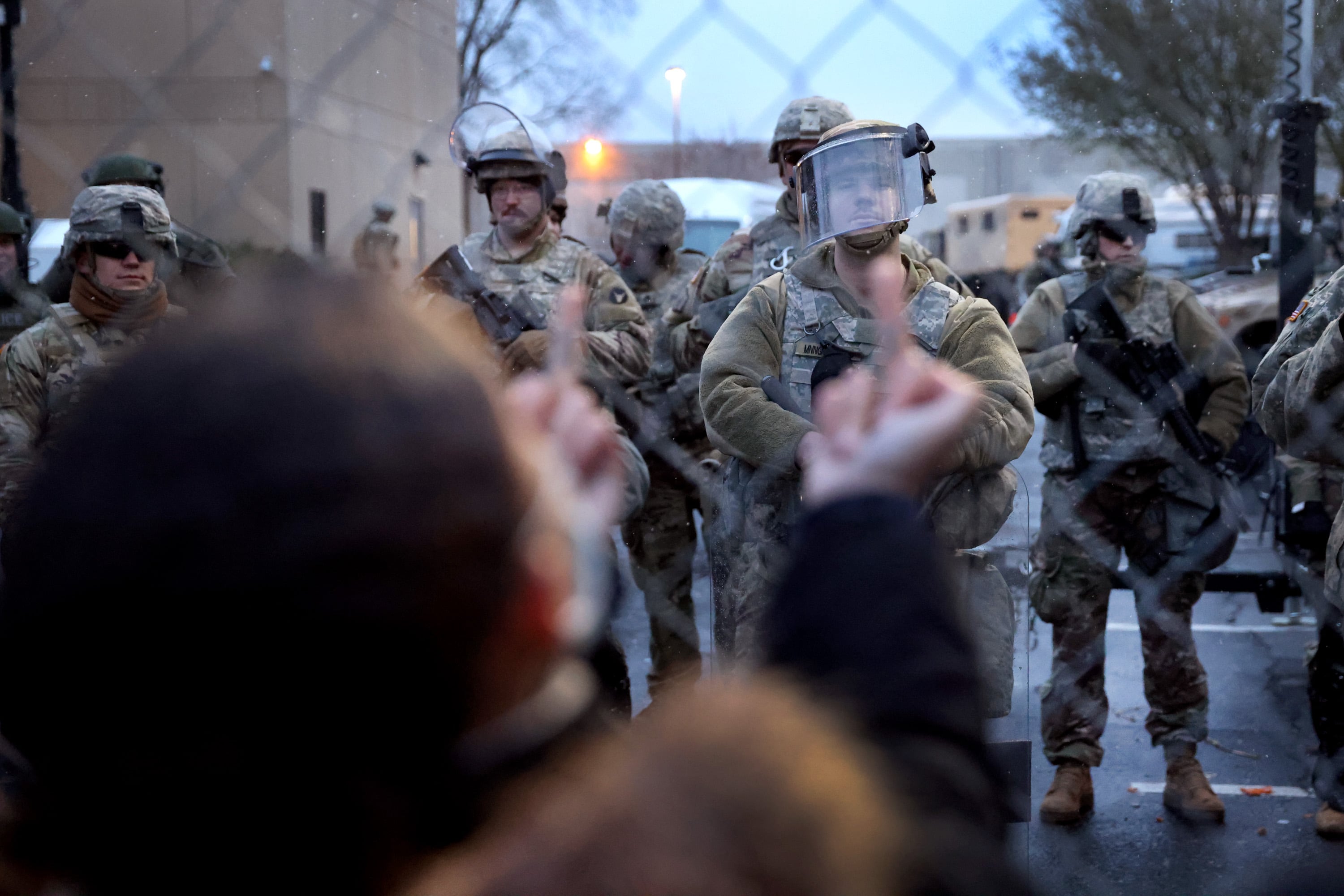
But the worst fears for this beleaguered region ebbed Tuesday after a jury found Chauvin guilty of second- and third-degree murder, as well as second-degree manslaughter.
Regardless of whether they felt the Guard deployment was a prudent measure or an overreach that furthered the trauma here, residents interviewed by Military Times all agreed that uniformed military on the corner was a surreal and discomfiting spectacle.
The 12-hour shifts for Guard teams stationed across the city have been largely uneventful, the sergeant said Wednesday.
“Lotta bullshitting, lotta jokes,” he said.
But early Sunday, shots were fired at several Guardsmen on the city’s north side, with one sustaining minor injuries that required hospitalization.
Andrew Thomas, 28, has been arrested and charged in the 4:20 a.m. shooting, according to the U.S. Attorney’s Office.
And while they strived to be a non-threatening presence in the city, the sergeant told Military Times that everyone was ordered to wear their helmets and vests during shifts after the shots were fired.
Protecting themselves while not coming off as jackbooted occupiers has been a fine line to walk, he said.
“It makes things a little more real,” the sergeant said of the shooting incident. “You put your head on a swivel and pay attention to your surroundings.”
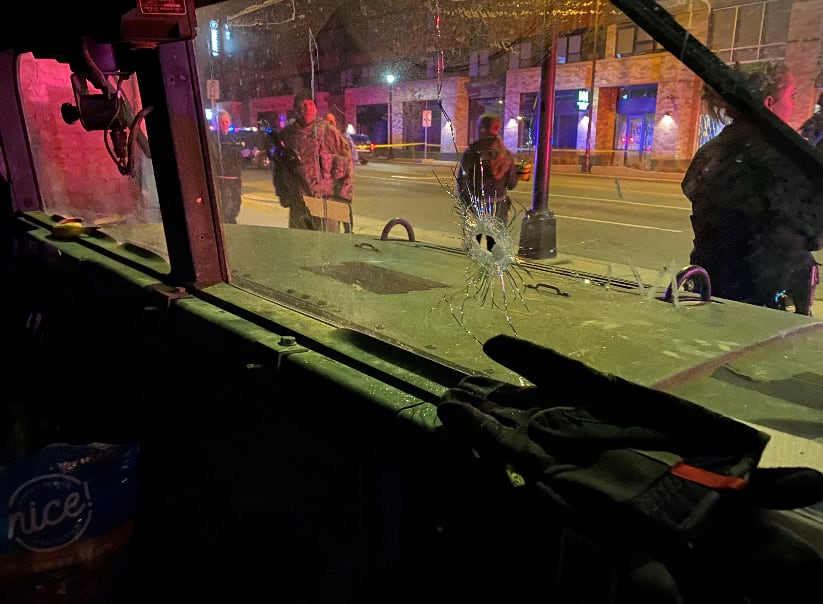
He also keeps an eye on anyone who yells things at them in passing.
“I hate to think negatively about people, but you never know,” the sergeant said.
Roughly 500 of the activated Guard members hail from the Twin Cities metro area, according to Maj. David Adams, a spokesman with the Guard’s 34th Infantry Division, one of the main units providing troops for Operation Safety Net.
Adams said Wednesday that the Guard deployment would be ramping down this week.
Mobilizing a week early in response to unrest in the wake of the Wright shooting was difficult, Adams said, but the entire mission was a challenging one in general.
“For our individual service members out on the streets, they have to put their own feelings and opinions aside while dealing with some of the most challenging situations of many of their careers,” Adams said in an email. “It’s challenging to process everything they’re dealing with internally while working long, stressful shifts and receiving all range of interactions from the public. They don’t have the benefit of being at home, in their own private space to process everything that’s happening.”
Aside from the shooting incident, social media posts emerged of Guard vehicles being pelted by debris in Brooklyn Center and residents scrawling “go home” messages in front of soldiers on local sidewalks, this recent deployment appears to have been largely quiet.
But as midnight neared on Tuesday, hours after Chauvin’s conviction, downtown was at rest, as if the adrenalized emotion of the past year had receded.
Several young Guard members sat in the back of their truck, eating pizza. All the time in the world to kill. The epitome of military life. Hurry up and wait.
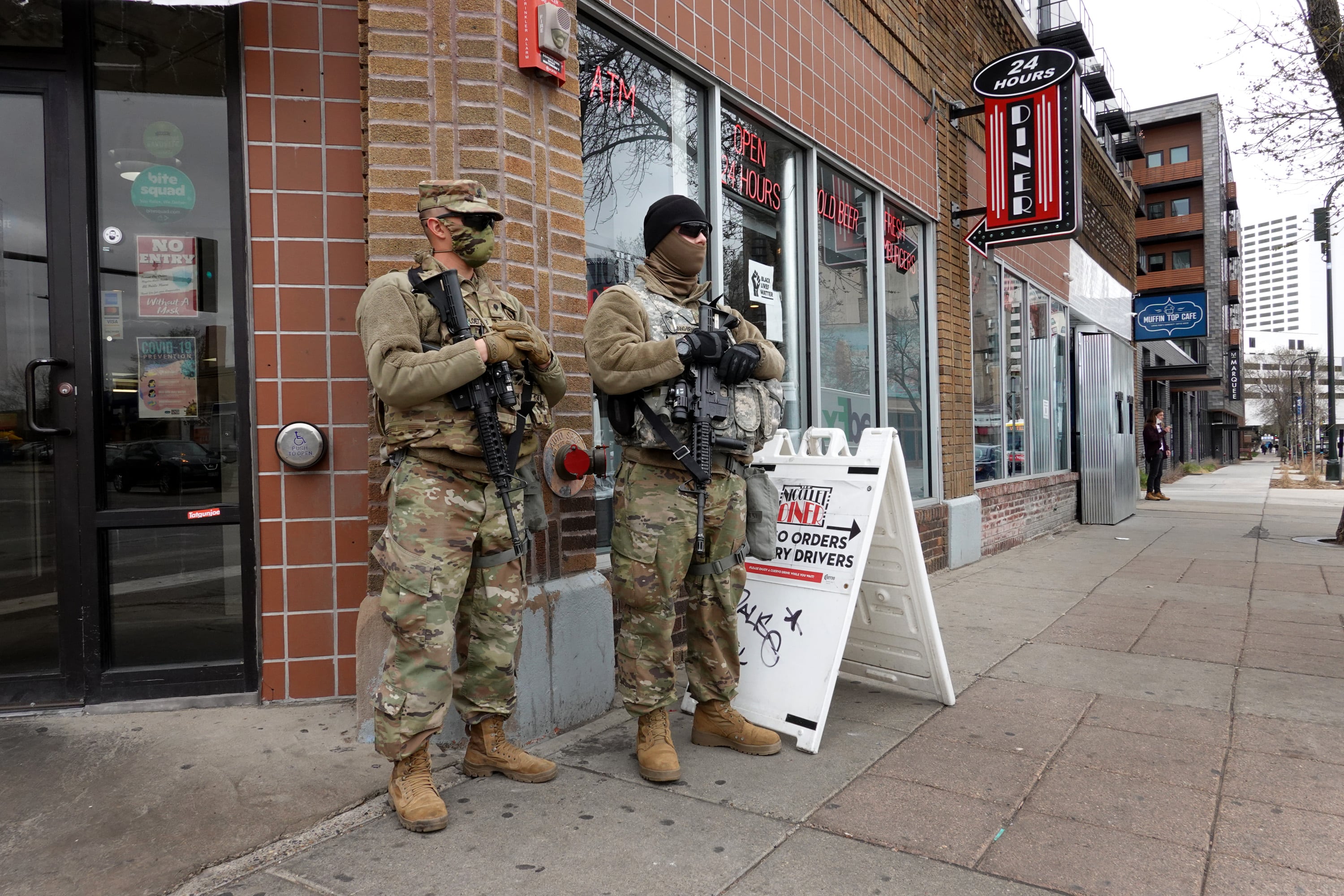
“They think we’re foreign occupiers”
The sergeant said most interactions with residents have been congenial, but some locals do yell things at them.
On Wednesday afternoon, one specialist greeted a passing woman in a hijab with a traditional Islamic greeting.
After she returned it, the soldier said he felt that “it’s great to be on this side of history, doing your part for your community.”
Another specialist said he tries to schmooze with curious passersby.
“I invite a lot of people over to take pictures and talk,” the soldier said.
A private noted that they were often phone recorded, and he checked his Snapchat map regularly to see if anyone in the area had posted videos of him and his fellow soldiers.
“We’re not here as an occupier,” the sergeant said. “We’re here to make people feel safe and not get their businesses wrecked.”
Guard teams rotate between sites, and the sergeant said that some businesses have been more welcoming than others.
Some let soldiers use their bathrooms, he said, while others do not.
None of the sergeant’s soldiers had magazines in their rifles Wednesday, and the sergeant said he tells his men and women to try and cover up their magazine pouch if they can.
To come off as non-threatening as possible, the sergeant said he also directs his soldiers to keep their magazines upside down in their pouch, so that if it opens accidentally, locals don’t see the bullets at the top.
The Guard posts were set up largely at the request of local law enforcement, and many of those posts included civilian police.
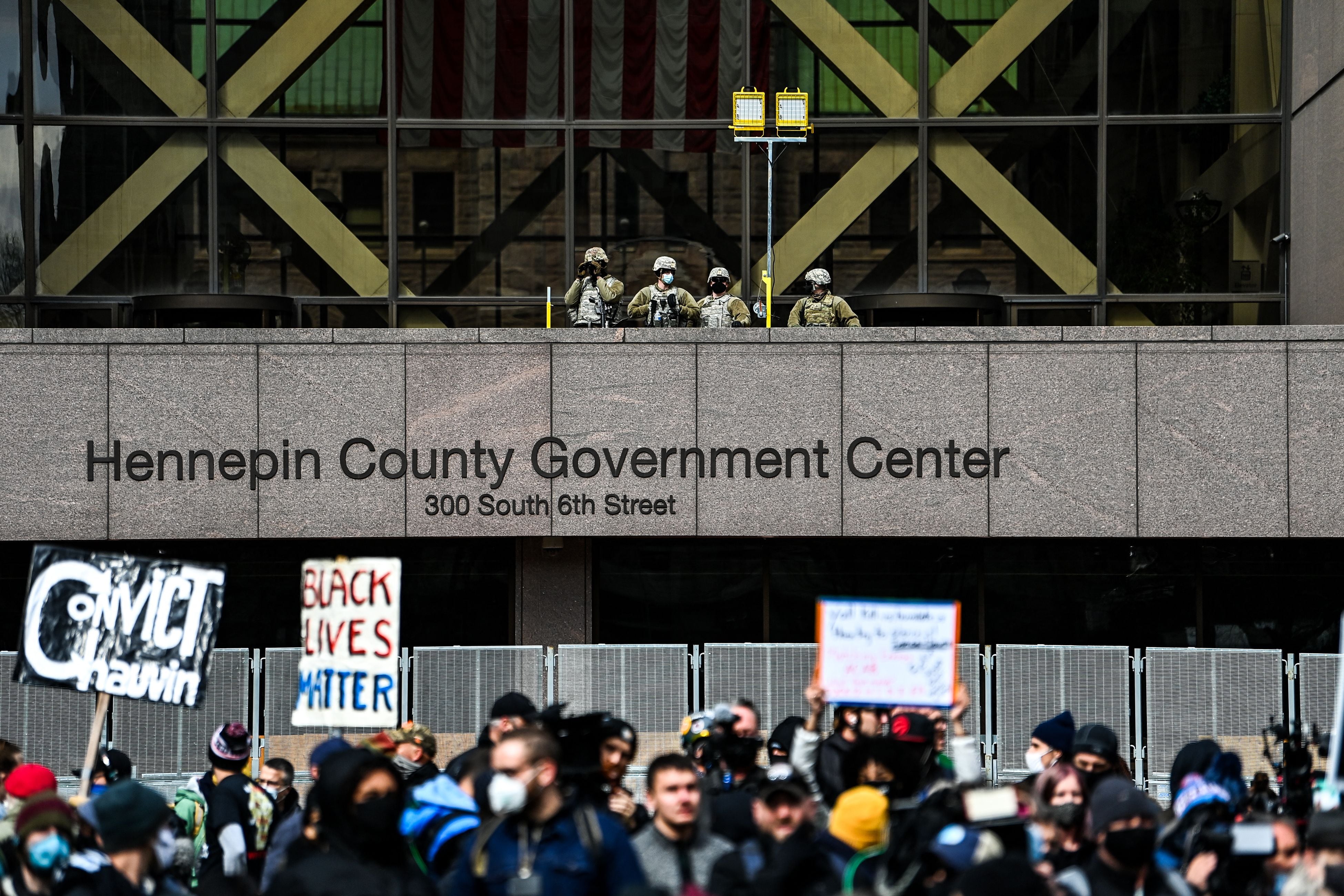
Adams, the Guard spokesman, said the soldiers are there to serve as “sensors and support” for civilian law enforcement, and did not make any arrests.
The sergeant said he was comfortable with the rules of engagement that they were given.
“You can’t do anything with that mag until we receive guidance from higher headquarters,” he said. “I could make that call but I better be damn sure.”
The Guard sergeant said civilian cops would handle any potential friction with the public.
“I’d have to be pretty lost in the sweet tea to use my mag,” the sergeant said. “I hope it never has to leave my pouch, except to turn it in.”
The Guard was activated last summer as a rapid-response force following Floyd’s murder, as some who took to the streets in protest turned destructive, resulting in millions of dollars’ worth of property damage to more than 1,500 locations in the area, the Star Tribune reported in July.
One Guard officer said he raced to muster and head to the Twin Cities with an hour’s notice last summer, and soldiers were sleeping in repurposed hockey rinks.
But the grim contingency that brought soldiers to Minneapolis’ streets this year was long in the planning, said the officer, who requested anonymity because he wasn’t authorized to speak publicly.
He said he wished he could allay the fears some residents have of the soldiers, and “the middle thumb up” he and his unit sometimes received from passersby.
“A lot of people don’t understand what the National Guard is,” the officer said. “A lot aren’t used to seeing us in uniform. They think we’re foreign occupiers. They don’t know we joined to get college.”
If Chauvin had walked, the officer said he hoped anyone looking to cause harm “would see us and just move elsewhere.”
Residential reactions
Minneapolis residents interviewed by Military Times differed in how they felt about the military presence in their city.
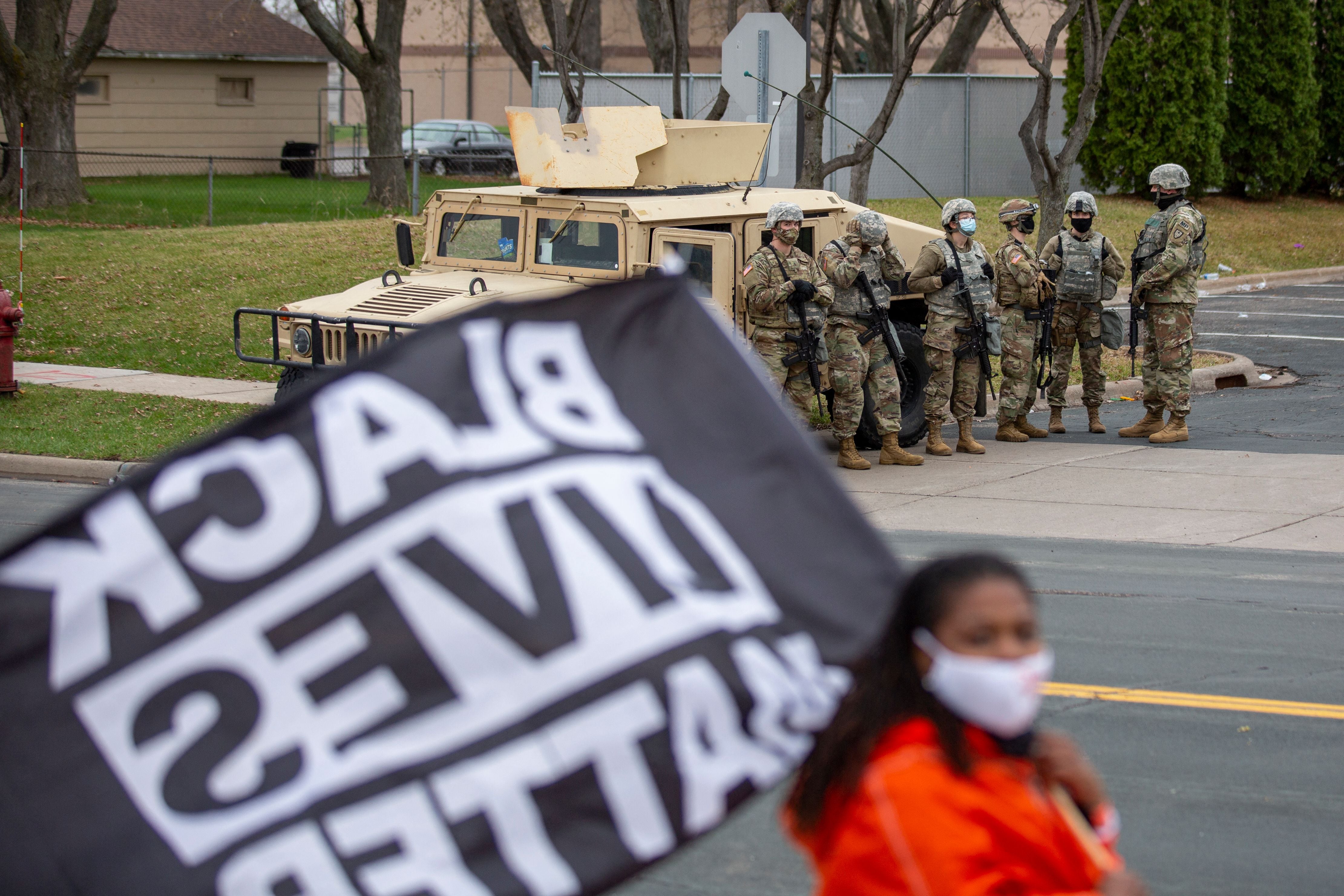
Walking from a joyful march celebrating Chauvin’s conviction Tuesday night, Vinicius Taguchi said he thought the Guard’s presence was harming the scarred city.
Taguchi said he thought the protest movement would be more able to police its own this time around if an acquittal brought people into the streets again.
“They are not needed,” he said of the soldiers. “They are creating greater traumas here.”
Ace Williams watched the procession, which organizers corralled into the eastbound lanes of Washington Avenue.
Williams said he thought the Guardsmen had been a pretty low-key and benign presence in town.
“I can’t say that about the police,” he added. “I’m used to the military being deployed in foreign countries.”
Outside a Cub grocery store on Minneapolis’ predominantly Black North Side, Amakoe D’Almeida said Tuesday night that he felt safer with the soldiers in the back of the parking lot.
“You never knew what was going to happen after the verdict,” said D’Almeida, a native of Togo who has been in the states for 22 years.
D’Almeida said troops on the streets was a regular sight back home, but that if the Guard wasn’t in place and destruction started here, “it would be too late.”
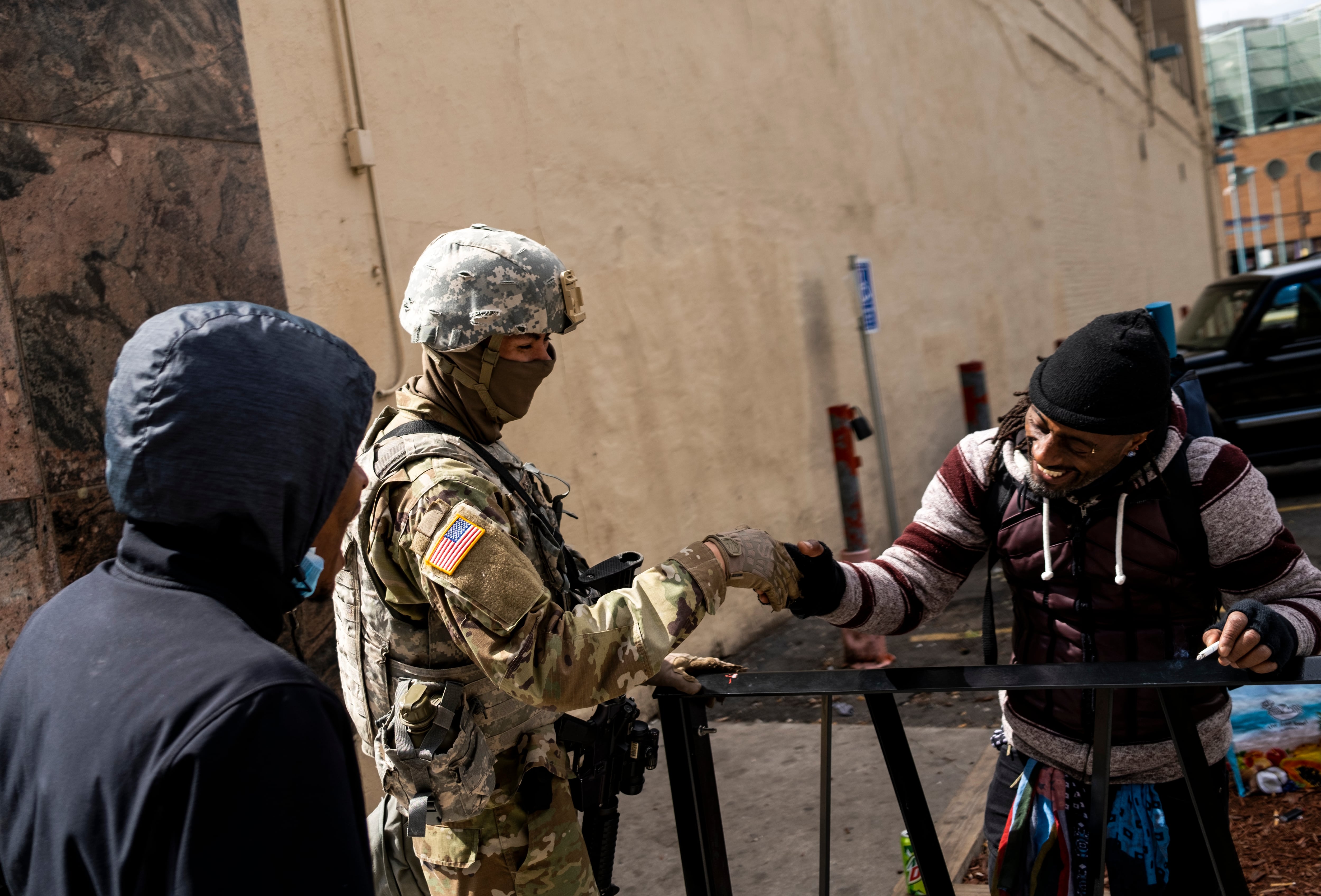
Trey Pollard leads the Minneapolis violence prevention group We Push for Peace, and said he has a brother and cousin in the military, so the sight of soldiers wasn’t off-putting for him.
“We love our soldiers,” Pollard told Military Times. “Five hundred of the National Guard troops are from right here in the Twin Cities area.”
Still, Pollard said he wished some of them weren’t so stone-faced and would engage with residents.
“They just seem so unfriendly,” he said.
Whether the Guard will be called out again in these unprecedented times of unrest remains to be seen.
Pollard was hopeful. But as such police killings continue — like Wright, the Brooklyn Center Black man that police fatally shot April 11 after being pulled over — so will the protests and cries for reform. Along with the potential for further destruction.
“Onto the next one,” Pollard said resignedly.
Second Lt. Devon Pendergast lives on the North Side and found himself guarding the North Side Cub foods where he does his grocery shopping.
The 23-year-old had mixed emotions as the Chauvin verdict loomed and was worried he’d see vital businesses in the neighborhood ransacked again.
“I live in a duplex,” he told Military Times. “A couple with a baby live above me. That crossed my mind a lot.”
The Cub was looted last year and wasn’t initially rebuilt, Pendergast said, leaving many area residents without a place to buy fresh food.
“It almost became a food desert,” he said. “Being there, protecting what I knew was a valuable grocery store, being surrounded by community organizers and the same people that helped us distribute diapers last summer, it was not only reassuring but validating of this mission.”
Pendergast praised his NCOs and junior soldiers for how they dealt with those who didn’t want them there.
“We got a lot of questions asking what state you’re from, are you guys Big Army?” he said. “The answer always ended up being no, we are one of you…this is my neighborhood.”
Geoff is the managing editor of Military Times, but he still loves writing stories. He covered Iraq and Afghanistan extensively and was a reporter at the Chicago Tribune. He welcomes any and all kinds of tips at geoffz@militarytimes.com.
